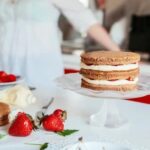The art of cake decorating is a beautiful and intricate craft that has been captivating people for centuries. From simple birthday cakes to elaborate wedding designs, cake decoration plays an essential role in transforming a delicious baked good into a stunning masterpiece. As the demand for unique and creative cakes continues to grow, so does the need for skilled and professional cake decorators.
In this article, we will explore what it takes to become a professional cake decorator. We will delve into the importance of cake decoration and its growing popularity in today’s baking industry. Whether you dream of opening your own bakery or simply want to pursue a fulfilling hobby, this guide will provide you with valuable insights and tips on how to turn your passion for cake decorating into a successful career.
Becoming a professional cake decorator is not just about having a talent for creating visually appealing designs – it also requires dedication, practice, and continuous learning. In the following sections, we will discuss various aspects of honing your skills as a cake decorator. From developing your passion for baking and cake decoration to acquiring the necessary skills and mastering different decorating styles, we will guide you through the journey towards becoming a true professional in this field.
So if you have always admired beautifully decorated cakes or find joy in bringing happiness to others through edible creations, join us as we dive into the world of professional cake decorating. With perseverance and the right knowledge, you can turn your love for baking into an exciting career where every new creation becomes a work of art.
Developing Your Passion for Baking and Cake Decorating
Developing a passion for baking and cake decorating is the first step towards becoming a professional cake decorator. This section will explore various ways to ignite and enhance your interest in this art form.
One of the best ways to develop your passion for baking and cake decorating is by exploring your interest. Start by experimenting with simple recipes at home and practicing basic techniques. This will help you gauge your level of interest and determine if it is something you truly enjoy.
To enhance your skills, consider taking classes or joining workshops specifically focused on baking and cake decoration. These courses provide valuable hands-on experience, guidance from professionals, and exposure to new techniques. Additionally, they allow you to connect with like-minded individuals who share similar interests, creating opportunities for growth and learning.
Finding inspiration is essential in developing a personal style in cake decorating. Explore different sources such as magazines, online platforms, or even attending local bakery expos to get inspired by other cake decorators’ work. Experiment with different designs, flavors, and textures to develop your unique approach to cake decoration.
In summary, developing a passion for baking and cake decorating involves exploring your interest through hands-on practice, taking classes or workshops to enhance your skills, and finding inspiration from other cake decorators’ work. This foundation will set the stage for acquiring the necessary skills needed to excel as a professional cake decorator.
| Year | Revenue of Bakery Industry (in billions) |
|---|---|
| 2015 | 7.02 |
| 2016 | 8.76 |
| 2017 | 10.51 |
| 2018 | 12.15 |
Source: Statista.com.
Acquiring the Necessary Baking and Decorating Skills
Developing the necessary baking and decorating skills is a crucial step in becoming a professional cake decorator. This section will outline the key elements to focus on in order to master the art of cake decoration.
Firstly, it is essential to start with honing your basic baking techniques and recipes. This includes learning how to properly measure ingredients, mix batter, and bake cakes to perfection. Understanding different types of cakes, such as butter cakes, sponge cakes, and chiffon cakes, will also expand your repertoire as a cake decorator.
Once you have a solid foundation in baking, it is important to familiarize yourself with various decorating tools and equipment. These may include piping bags and nozzles, spatulas for spreading icing, cake stencils for creating patterns, and fondant tools for shaping and sculpting designs. Knowing how to use each tool effectively will allow you to create precise and detailed decorations on your cakes.
Practicing essential cake decorating techniques is another vital aspect of acquiring the necessary skills. This includes mastering icing techniques such as smoothing buttercream or creating textured effects, piping techniques for borders or intricate designs, and working with fondant to create smooth coverings or 3D decorations. Regular practice will help build your confidence and proficiency in these techniques.
| Key Elements | Description |
|---|---|
| Basic baking techniques | Mastering measurement, mixing batter, and baking different types of cakes |
| Decorating tools and equipment | Familiarizing yourself with various tools such as piping bags, spatulas, stencils, and fondant tools |
| Essential cake decorating techniques | Practicing icing, piping, and fondant work to create professional-looking designs |
Mastering Different Cake Decorating Styles
As a professional cake decorator, it is important to have a solid understanding of different cake decorating styles. This knowledge will not only allow you to create cakes that cater to a variety of client preferences, but it will also help you develop your own unique style as a decorator. Here are some key points to consider when seeking to master different cake decorating styles:
- Understand the different styles of cake decoration: From modern and sleek designs to classic and elegant ones, there are various decorating styles that can be applied to cakes. Take the time to research and familiarize yourself with these different styles. Look for inspiration in books, magazines, websites, and even social media platforms like Pinterest or Instagram.
- Learn to adapt your style: While it is important to have your own style as a cake decorator, it is equally important to be able to adapt your style to meet the preferences of your clients. Some clients may prefer a more traditional look while others may want something more whimsical or unique. Being able to customize your designs based on client preferences will set you apart as a versatile professional.
- Experiment with unique techniques: To truly stand out as a cake decorator, don’t be afraid to experiment with unique techniques and incorporate them into your designs. Try out different piping techniques, explore innovative ways of using fondant or edible decorations, or experiment with new flavors or textures in your cakes. This sense of creativity and innovation will make your cakes memorable and sought after.
By mastering different cake decorating styles, you’ll not only expand your repertoire as a professional baker but also attract a wider range of clientele who appreciate diverse design aesthetics. Remember that practice makes perfect, so keep honing your skills and never stop experimenting with new techniques and styles.
- Understand the different styles of cake decoration
- Learn to adapt your style
- Experiment with unique techniques
Building a Professional Cake Decorating Portfolio
One of the key elements in establishing yourself as a professional cake decorator is having a strong portfolio that showcases your skills and creativity. A professional portfolio not only serves as a visual representation of your work but also acts as a tool to attract potential clients and set yourself apart from other decorators in the industry.
When building your cake decorating portfolio, it is important to gather high-quality photographs of your cake designs. Invest in a good camera or hire a professional photographer to capture your cakes in clear and detailed images. Make sure to capture different angles, close-ups of intricate details, and overall presentation. These photos will be the first impression potential clients have of your work, so it’s crucial that they accurately showcase your skills and style.
In addition to showcasing your technical skills, it’s important to include a diverse range of cake decorating styles and techniques in your portfolio. This helps demonstrate your versatility as a decorator and shows potential clients that you are capable of creating cakes for various occasions and preferences.
Include examples of different icing techniques, piping designs, fondant work, and any other unique techniques you specialize in. Additionally, consider including cake designs that cater to different themes such as weddings, birthdays, anniversaries, or seasonal celebrations.
To ensure that your portfolio stays up-to-date and relevant, continuously add new cake designs whenever possible. It’s important to regularly challenge yourself by experimenting with new trends, techniques, and styles. Stay inspired by following industry blogs or magazines for fresh ideas. Additionally, consider collaborating with other professionals in the baking or event planning industry to expand your network and learn from others’ expertise.
Building a professional cake decorating portfolio takes time and effort but is essential for establishing credibility within the industry. A visually appealing collection of high-quality photographs showcasing various styles and techniques will not only attract potential clients but also set you apart from competitors in the field. Keep updating your portfolio with new designs regularly to stay relevant and continuously improve as a professional cake decorator.
Effective Marketing and Networking for Cake Decorators
In today’s competitive market, effective marketing and networking are crucial for the success of professional cake decorators. Building a strong online presence is one of the most effective ways to showcase your work and attract potential clients. Utilizing social media platforms such as Instagram, Facebook, and Pinterest can help you reach a larger audience and gain visibility in the industry.
Creating visually appealing content is key when marketing your cake decorating services online. Regularly posting high-quality photographs of your cake designs will not only showcase your skills but also establish your brand image. Consider using captions to engage with your audience and provide behind-the-scenes glimpses into your creative process. Additionally, using relevant hashtags will make it easier for people to discover and follow your work.
Collaborating with local businesses and event planners is another effective way to network in the cake decorating industry. By working together on different projects or events, you can expand your professional network and gain referrals from other professionals. Reach out to local bakeries, wedding venues, or party planners to explore potential collaboration opportunities.
Creating an online portfolio through a website or blog can further enhance your marketing efforts. This allows potential clients to view a variety of cake designs conveniently in one place. Your website should include high-resolution images of your work, information about the services you offer, pricing details, testimonials from satisfied clients, and contact information for inquiries.
Overall, effective marketing and networking strategies are vital for success as a professional cake decorator. By leveraging social media platforms, collaborating with local businesses, and maintaining an online portfolio, you can increase visibility in the industry and attract more clients to your business.
- Utilize social media platforms such as Instagram, Facebook, and Pinterest
- Regularly post high-quality photographs of your cake designs
- Use captions and hashtags to engage with your audience
- Collaborate with local businesses and event planners
- Create an online portfolio through a website or blog
Pricing Your Cake Decorating Services
Determining the cost of your cake decorating services is a crucial aspect of running a successful business as a professional cake decorator. Pricing your cakes appropriately ensures that you are fairly compensated for your time, skills, and resources while also remaining competitive in the market. In this section, we will explore the key factors to consider when setting prices for your cake decorating services.
Determining the Cost of Ingredients, Equipment, and Time
The first step in pricing your cake decorating services is to calculate the cost of ingredients, equipment, and time involved in each cake. Make a list of all the ingredients you use regularly and their respective costs. Factor in any specialized tools or equipment needed for specific designs as well. Additionally, estimate the amount of time it takes you to bake, decorate, and deliver each cake.
Consider both direct and indirect costs. Direct costs include items that are used up with each order such as flour, buttercream frosting, fondant, food colors, etc. Indirect costs include items that are not used up with each order but contribute to overall expenses such as baking pans, piping bags, decorating tips, electricity for baking ovens.
Research Market Prices
It’s important to research and understand market prices in your area to ensure that you are setting fair prices while remaining competitive. Research what other professional cake decorators charge for similar designs and sizes of cakes. Take into consideration factors such as experience level, quality of workmanship, reputation within the community when comparing prices.
Remember that pricing should be based on a fair profit margin after all expenses have been accounted for – not just covering costs. If you consistently underprice your products and services without considering profitability, it can become unsustainable in the long run.
Setting a Pricing Structure
Once you have determined all the necessary costs and researched market prices, it’s time to set a pricing structure that reflects your skills and experience as a professional cake decorator. Consider whether you want to charge per serving, per hour, or offer package deals for specific events like weddings or birthdays.
Be transparent about your pricing structure and clearly communicate it to potential clients. Create a pricing list or brochure that showcases different cake sizes, designs, and corresponding prices. Display your prices on your website or social media platforms to help clients easily understand what they can expect to pay for your services.
Remember that pricing is not set in stone and can evolve over time as you gain more experience and demand for your work increases. Regularly assess and adjust your prices based on market trends, changes in expenses, and the value you bring as a professional cake decorator.
By carefully considering these factors when determining the cost of your cake decorating services, you can ensure that you are running a profitable business while delivering high-quality cakes to satisfied customers.
Tips for Successful Cake Delivery and Set-Up
Ensuring Cakes Arrive Safely
One of the most important aspects of being a professional cake decorator is ensuring that your cakes arrive at their destination safely. The last thing you want is for all your hard work to be ruined during transportation. To ensure successful cake delivery, it is essential to invest in proper packaging materials and transportation methods.
When transporting tiered cakes, it is crucial to stack them securely and stabilize them with dowels or support systems. This will minimize the risk of the layers shifting or collapsing during transit. Additionally, using non-slip mats or grip bases under each tier can provide an extra level of stability.
To protect the decorations on your cakes, consider using a cake box with enough room for additional padding such as bubble wrap or foam inserts. Wrapping delicate decorations in plastic wrap can also help prevent damage during transit. It’s always a good idea to have an emergency kit on hand with extra icing, piping bags, and any other supplies that may be needed in case of any mishaps during transportation.
Proper Transportation and Packaging Techniques
Choosing the right mode of transportation is vital when delivering cakes. If possible, opt for a vehicle with a flat surface floor to avoid tilting or sliding during transport. Ensure that there are no sudden sharp turns or heavy braking while driving with a cake in tow.
If you need to deliver multiple cakes at once, consider investing in stackable cake carriers. These specially designed containers allow you to transport multiple cakes without compromising their structural integrity. Alternatively, renting a refrigerated van can help keep your cakes fresh and stable during long journeys.
Remember to place heavier and sturdier cakes at the bottom when stacking them in your vehicle. Always allow sufficient time for delivery so that you are not rushing, which can increase the chances of accidents or damaged goods.
Efficiently Setting Up and Arranging Cakes
When it comes to setting up cakes at events or venues, precision and attention to detail are crucial. Begin by finding a stable and level surface where the cake will be displayed. Use a level tool to ensure that the cake is perfectly straight.
For tiered cakes, assemble them on-site if possible to avoid any mishaps during transportation. Assemble each tier one at a time, ensuring stability before adding the next layer. If necessary, have an assistant help you with assembling and arranging the cake to guarantee a smooth process.
Once your cake is set up, decorate the surrounding area with complementary elements such as flowers or table decorations that enhance the overall presentation. Take photos of the finished cake before leaving the event as part of your portfolio development.
By following these tips for successful cake delivery and set-up, you can ensure that your clients receive their cakes in pristine condition and create an impressive display at every event or venue.
Conclusion
Becoming a professional cake decorator requires dedication, passion, and a willingness to continuously learn and improve. Throughout this article, we have discussed the importance of cake decoration and the growing demand for skilled decorators. We have also explored the various steps involved in becoming a professional cake decorator, from developing your passion for baking and cake decorating to mastering different styles and building a professional portfolio.
It is essential to remember that success in any field takes time and effort. As you embark on your journey to becoming a professional cake decorator, be prepared to invest time in honing your skills. Explore your interest in baking and cake decoration by taking classes or joining workshops. These opportunities will not only enhance your skills but also provide inspiration and help you develop your personal style.
Acquiring the necessary baking and decorating skills is crucial for any aspiring professional cake decorator. Practice essential techniques such as icing, piping, and fondant work, while also familiarizing yourself with various decorating tools and equipment. Additionally, strive to master different cake decorating styles to meet client preferences and experiment with unique techniques that make your cakes stand out.
Building a professional portfolio is another key aspect of becoming a successful cake decorator. A well-curated portfolio showcases your range of skills, styles, and creativity. Gather high-quality photographs of your cake designs that highlight your best work. By presenting a diverse array of cakes that showcase different techniques and styles, you will attract potential clients who can see the depth of your abilities.
While technical skills are vital for success as a professional cake decorator, effective marketing and networking strategies are equally important. Utilize social media platforms to showcase your work and attract clients. Collaborate with local businesses and event planners for networking opportunities that can lead to future bookings. And consider creating an online presence through a website or blog to expand your reach even further.
Lastly, staying updated on industry trends is crucial for continuous improvement as a professional cake decorator. Be proactive about learning new techniques and experimenting with different styles. Attend workshops, seminars, and industry events to connect with fellow cake decorators and stay inspired. Take advantage of online resources such as blogs, tutorials, and forums that offer tips and insights into the latest trends in cake decoration.
In conclusion, becoming a professional cake decorator is an exciting career path for those with a passion for baking and creativity. By following the steps outlined in this article and continuously honing your skills, you can build a successful career in this field. Embrace the challenges, continue seeking inspiration, and never stop learning. With dedication and perseverance, you can achieve your goals as a professional cake decorator.
Frequently Asked Questions
How long does it take to become a good cake decorator?
The time it takes to become a good cake decorator can vary depending on the individual and their level of dedication, practice, and natural artistic talent. Generally, becoming proficient in basic techniques may take several months of consistent practice. However, mastery and expertise in more intricate designs and styles often require years of experience.
Becoming a truly skilled cake decorator is an ongoing process that involves continuously learning new techniques, staying updated with current trends, and experimenting with unique ideas. It requires patience, perseverance, and a passion for refining one’s skills in order to create beautiful and visually appealing cakes.
How much do top cake decorators make?
The income of top cake decorators can vary depending on various factors such as location, experience, reputation, client base, and the scale of their operations. While there is no fixed salary for cake decorators, some experienced professionals who have established themselves as experts in the field can earn a substantial income from their work.
These individuals may be able to charge higher rates for their custom-made creations or be commissioned for high-profile events or celebrity clientele. Additionally, successful cake decorators may also supplement their earnings through teaching classes or selling books or merchandise related to their craft.
Is being a cake decorator stressful?
Like any profession that involves creativity and working under deadlines, being a cake decorator can have moments of stress. Cake decorators often have to juggle multiple orders at once while ensuring each design meets client expectations within specific timeframes. Deadlines can be tight when catering to events like weddings or birthdays where clients expect perfection on the specified date.
The pressure of creating intricate designs using delicate ingredients can also add stress during high-demand periods such as holiday seasons or special occasions. However, many cake decorators find immense satisfaction in seeing their creations come to life and bringing joy to others through their artistry despite occasional stressful situations. With experience and effective time management skills, cake decorators can mitigate much of the stress associated with this profession while focusing on honing their craft and creating stunning masterpieces.

Welcome to my blog about home and family. This blog is a place where I will share my thoughts, ideas, and experiences related to these important topics. I am a stay-at-home mom with two young children. I hope you enjoy reading it! and may find some helpful tips and ideas that will make your home and family life even better!





